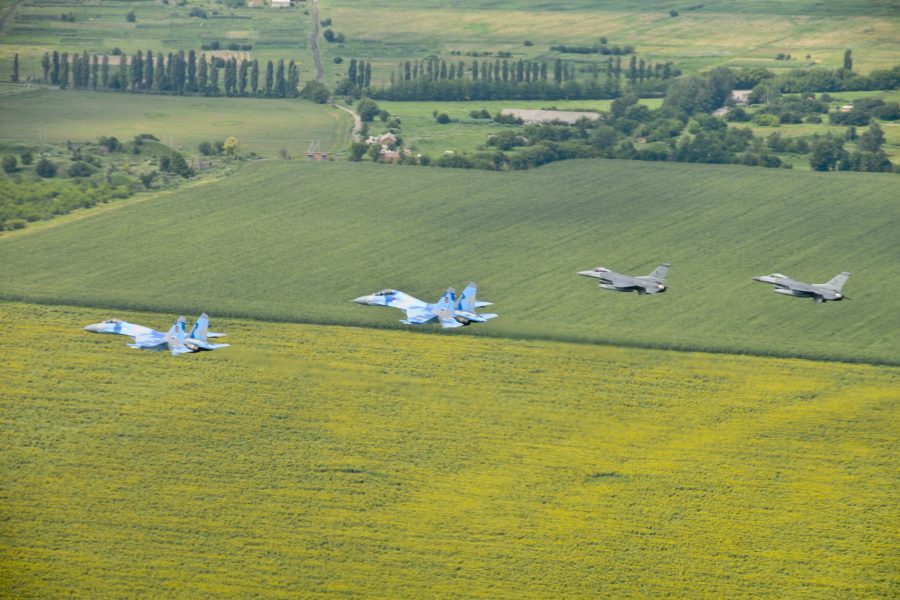The U.S. and Western allies expect the Ukrainian Air Force to achieve “initial operating capability” on F-16s by the end of this year, a senior Pentagon official said Jan. 23.
F-16 pilot training by the U.S. and European countries is “on track,” assistant secretary of defense for international security affairs Celeste Wallander told reporters. But the effort to provide Kyiv with the stalwart American fighter is complex one, she said.
“We are aiming to provide an initial operating capability for Ukraine with its F-16 program in 2024, which would entail trained pilots, the platforms, but in addition, trained maintainers and sustainers, infrastructure, and spare parts, ammunition,” Wallander said after a virtual meeting of the Ukraine Defense Contact Group, a gathering of some 50 countries that coordinates military aid to Kyiv. Efforts to provide F-16s fall under the Air Force capability coalition—one of several groups set up to focus on specific needs.
“All of these pieces is what the coalition’s responsible for, and so we gave a briefing on where that stood this year,” Wallander said, though she did not provide further details.
U.S. and Ukrainian officials have been coy on the training specifics. The spokesman for the Ukrainian Air Force, Yurii Ihnat, said the West is “training our pilots very, very confidentially” in remarks on Ukrainian television Jan. 22. The 162nd Wing of Arizona Air National Guard in Tucson, Ariz.—the home of the Air Force’s foreign F-16 pilot training—is providing the U.S. training to “several” Ukrainian pilots, the Pentagon says. European countries are also conducting training, led by Denmark.
A more immediate concern in Washington and other Western capitals is the ability to keep providing current capabilities to Ukraine, let alone new ones.
The Pentagon says it has no more aid packages to give after running out of funding—the DOD still has roughly $4 billion in authority to take stock out of its inventory to give to Ukraine, but it does not have money to replenish those stocks. Meanwhile, European allies have lagged in promises to ramp up critical artillery production.
Some U.S. aid promised in previous assistance packages is still rolling in, while long-lead items, such as contracts awarded under another funding program, the Ukraine Security Assistance Initiative (USAI), have yet to be produced.
“We do continue to provide support, for example, training, and of course, leadership,” Pentagon Press Secretary Air Force Maj. Gen. Patrick S. Ryder said Jan. 23. “But the point is, in order for us to provide the capabilities that Ukraine needs on the battlefield today, but also in the longer term, we would really appreciate the support of Congress.”
Ukraine aid funding is tied up in Congress as part of a broader political dispute over border security and government spending.
Pilot training is not affected by the funding issue, the Pentagon says. But while some American officials predicted ambitious F-16 training timelines after the Biden administration gave the sign-off late last summer, both the West and Ukraine have now tempered expectations.
Ryder said in November shortly after American training of Ukrainian pilots began that instruction would take five to nine months, with the timeline “very much predicated on the skill level of the individual pilots.” Ukrainian pilots are transferring over from twin-engine Soviet-style Sukhois and MiGs to single-engine, multi-role F-16s, an added learning curve.
“That’s an assessment that essentially is tailored to the current situation,” Ryder said of the training timeline. A typical F-16 training course with the 162nd Wing takes roughly six months.
The F-16, which first flew almost exactly 50 years ago, has been steadily upgraded over the years, and could employ weapons such as AIM-120 AMRAAM air-to-air missiles to protect Ukraine’s skies from Russian missile and drone attacks. AMRAAMs, which are also used in NASAMS air defense systems, have been hinted at as a possible weapon for Ukraine’s F-16s by Ukrainian and U.S. officials. Some American weapons, including JDAM Extended Range guided bombs and HARM anti-radiation missiles have already been jerry-rigged to Ukraine’s legacy fleet.
While specifics of training remain murky, many materiel questions remain. Denmark has pledged 19 used F-16s and the Netherlands says it will give 42 jets, but exactly when those planes will arrive is unclear. Norway and Belgium are also donating F-16s. The first Danish planes have been delayed until the second quarter of 2024. How Ukraine will maintain F-16s has also not been fully spelled out. Nor it is clear what type and who would provide the weapons for the F-16s. The U.S. does not plan to provide its own F-16s but must sign off on any transfer.
The lack of airpower has become one of the defining features of the war in Ukraine—instead, missiles and drones come from afar. Russia’s aircraft have largely been confined to standoff range due to Ukraine’s air defenses. But Russia has advanced surface-to-air systems of its own, including S-400 long-range systems based inside the Russian Federation—which has been deemed off limits for Ukraine to target using Western-provided weapons—and in occupied Crimea, forcing Ukrainian Air Force pilots to fly low and try to mask themselves with the terrain. As a result, neither side has air superiority.
“We have seen surges in Russian air activities against Ukraine,” Wallander said. “We’ve seen them not only continue to use ballistic missiles and cruise missiles and UAVs, but we have seen periods in which they are using coordinated barrages of those capabilities … to try to overwhelm Ukrainian defense capabilities in a particular location, but also to seek to force the Ukrainians to use ammunition to create vulnerabilities in Ukrainian civilian and critical infrastructure targets, but also front lines in order to be able to try to exploit those potential vulnerabilities.”
